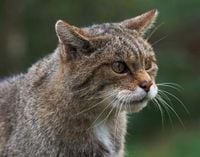Wildcats, Britain’s only remaining native cat species, are on the brink of a remarkable comeback in the south-west of England, thanks to a comprehensive two-year study that has ignited both hope and debate across the region. The South West Wildcat Project, spearheaded by Devon Wildlife Trust in partnership with Forestry England and the Derek Gow Consultancy, recently published its findings, suggesting that mid-Devon offers the ideal conditions for reintroducing these elusive felines—conditions that could support a thriving population after more than a century’s absence.
The wildcat, or Felis silvestris, once roamed widely across the British countryside, earning the nickname “woodcat” for its woodland haunts. But centuries of persecution, hunting, and the relentless fragmentation of their habitats drove them to local extinction in England, with the last known populations on Exmoor disappearing by the 1920s, according to BBC. Today, only about 115 wildcats cling to survival in the Scottish Highlands, where their future remains precarious despite legal protection granted in 1988.
Now, a new chapter may be unfolding. The South West Wildcat Project’s research, published on November 18, 2025, concludes that the south-west contains enough woodland, low-intensity grasslands, and connected habitats to sustain a viable wildcat population. The area’s low density of towns and major roads—often a death knell for wildcats elsewhere in Europe—further strengthens its suitability. The project envisions a phased release of 40 to 50 wildcats, potentially beginning as soon as 2027 or 2028, with animals selected from Britain’s captive breeding program managed by the Royal Zoological Society of Scotland.
But the story is not just about ecology; it’s about people, too. Surveys conducted by the University of Exeter reveal overwhelming public support for the wildcats’ return. In one survey of 1,000 residents, 71% favored reintroduction, while another online poll saw 83% of 1,425 respondents express positivity. Across multiple sources, including BBC and Newshub, the consensus is clear: about 70%-80% of people in the region are ready to welcome wildcats back.
“It’s exciting that this report suggests wildcats could be part of the region’s nature once again,” said Cath Jeffs, the project lead at Devon Wildlife Trust, according to The Guardian. “The return of this critically endangered species would be another step in the restoration of our native wildlife and will help re-balance local ecosystems.” She added, “They’re critically endangered, why should we not bring them back, they were here and the reason they’re not here is because of persecution. They are part of our natural heritage.”
Wildcats are often mistaken for large tabby cats, but they are stockier, with a distinctive blunt-tipped tail. Their diet is dominated by small mammals—voles, rats, wood mice, and rabbits make up 75% of their prey, according to the feasibility study. By controlling populations of these animals, wildcats play a crucial role in maintaining healthy, diverse woodlands. They also help keep non-native species, like grey squirrels, in check.
Importantly, the research found that wildcats pose no significant risk to people, pets, endangered wildlife such as bats and hazel dormice, or livestock like lambs. Poultry farmers can employ the same protective measures they already use against foxes. “Wildcats would not be harmful to humans or to farm livestock and pets,” the study reassures, echoing findings from both BBC and The Guardian.
Yet, not everyone is without reservations. Farmers and conservationists alike have voiced concerns about the potential ripple effects on the local ecosystem. Oliver Edwards, a farmer from Exmoor, cautioned, “If the vole population diminishes due to wildcats, it would directly impact barn owls that depend on them for food.” The Countryside Alliance has also weighed in, emphasizing the need for meticulous planning to ensure the genetic purity of reintroduced wildcats and to prevent hybridization with feral domestic cats—a problem that has plagued Scottish populations.
“Without addressing these concerns, the project may not succeed,” warned Tim Bonner, chief executive of the Countryside Alliance, as reported by Newshub. To this end, the feasibility study recommends a robust neutering program for feral and domestic cats in the region, carried out in collaboration with local communities and cat welfare organizations. This measure is seen as critical to safeguarding the genetic integrity of the wildcat population.
Community engagement, it turns out, is not just a buzzword but a linchpin for success. The South West Wildcat Project has placed a premium on honest and open dialogue with stakeholders, including farmers, the shooting community, and concerned residents. “A lot of work remains to be done before the first wildcats could be released in the South West,” Cath Jeffs acknowledged. “Conversations with stakeholders such as farmers and the shooting community would be key.”
The project’s timeline remains tentative, with no immediate plans for release. Devon Wildlife Trust and its partners are now focused on securing the necessary funding and developing a comprehensive management plan that addresses the social, ecological, and logistical challenges ahead. If all goes well, around 50 wildcats could be gradually introduced over several years, with careful monitoring to ensure their integration into the landscape and minimal disruption to existing wildlife.
The wildcat’s absence from south-west England has been long and, for some, deeply felt. Their potential return is not just a matter of restoring a lost species but of rekindling a relationship between people and a landscape shaped by centuries of natural and human history. As Cath Jeffs put it, “They were once a widespread part of our countryside and today they remain an important part of woodlands throughout continental Europe including Germany, France, Spain and Italy.”
As the South West Wildcat Project moves from feasibility to planning, the eyes of conservationists, local communities, and nature enthusiasts alike are fixed on mid-Devon. The story of the wildcat’s return—if it happens—will be one of science, community, and the enduring power of hope in the British countryside.


